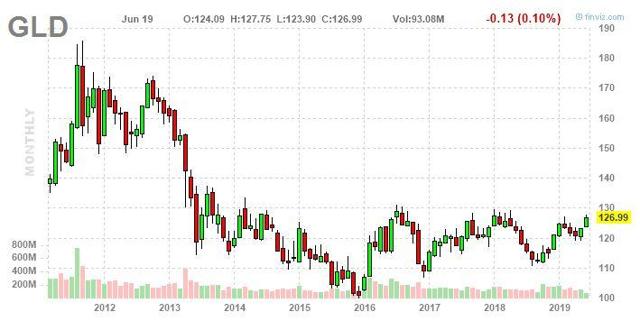Why Gold Could Finally Break Through Resistance
GLD has been stuck in a trading range for over six years and the area between $127 to $130 can be considered as the upper bound of this trading range.
GLD has attempted to break through resistance many times in the previous years and again in 2019, but so far has been unable to do it.
Stimulus from the Fed is not necessarily good for GLD because it helps stocks and deprives GLD from the capital it needs for prices to rise.
An escalating trade war will hurt stocks, which is what GLD needs to break through resistance and reach highs it has not seen in years.
Gold (GLD) is currently near the upper bound of the trading range that has kept it contained for the last six years. Back in late 2012/early 2013, GLD dropped from about $170 to $120 in a fairly short amount of time, a drop of almost 30%. GLD has since tried to recover, but the area between $127 to $130, or $1350 to $1380 in futures trading, has proven to be a tough nut to crack. GLD has tried several times in 2014, 2016 and 2018 to break through, but has failed to do so every time.
Fast forward to 2019 and we can see that resistance has so far kept GLD in check. Despite several attempts earlier this year and again in recent weeks, GLD has not been able to break through the area between $127 to $130. GLD remains in the trading range that it has stayed in for years, even though people have been hoping for a breakout over the years. But new developments on the geopolitical scene may finally change things.
Why I thought that long gold was not warranted despite easing from the Fed
In a previous article of mine from earlier this year, I questioned the assumption from some people that the pivot from the Federal Reserve towards monetary easing would be bullish for gold. Recall that earlier this year, the Fed became much more dovish. A sharp turnaround from the year before when the Fed hiked interest rates a total of four times.
Easy monetary policy in terms of low interest rates or even quantitative easing can give gold a boost. But as I pointed out in my article, stimulus from the Fed can also boost stocks. For instance, low interest rates can force people into the stock market and it allows for cheap financing for stock buybacks. What you then get is a competition between gold and stocks for investment. If the stock market rallies as it has in 2019, gold can be denied the capital it needs for prices to increase in a sustained fashion.
Gold prices will only rise if there are more buyers than sellers. If selling exceeds buying, then gold prices will drop. If one looks at recent history, we can find instances where gold prices went down instead of going up despite stimulus from the Fed. That is why I thought that the most probable path for gold was to challenge resistance and then bounce off.
Why I have changed my mind and now think that GLD may have a better chance this time
As I pointed out in my previous article that can be found here, gold needs another catalyst if it is to do what GLD investors have been hoping for the last several years. Easy monetary policy from the Fed is by itself unlikely to be enough as long as the stock market is rallying the way it has this year. The good news for GLD investors is that a new catalyst may just be around the corner.
Earlier this year, the general belief was that the trade dispute between the U.S. and China would be resolved and a deal was just a matter of time. However, President Trump decided to up the ante and raised tariffs from 10% to 25%. In addition, he has said that he may institute new tariffs on another $300 billion of Chinese imports. Other measures were also taken as part of the trade war with China. China is certain to retaliate in response, which means we could have ourselves a full-blown trade war.
China has a range of options when it comes to retaliation. One of them is to go after American companies that do business in China. This has become even more likely now that the U.S. has decided to target China's Huawei. China has already signaled that it may be heading into this direction by announcing that it will soon release a list of "unreliable entities." But regardless of which option China goes for, the stock market will not react well to an escalating trade war.
Unlike stimulus from the Fed which can help stocks, a full-blown trade war is negative for stocks. A trade war can have all sort of negative effects on companies such as raising input costs, lower company earnings, increase uncertainty, lower capital spending and so on. Trade wars can slow down the economy, which itself can force the Fed into more stimulus to prop up the economy.
It may take some time for things to filter through, but it will eventually happen. In fact, an argument could be made that the trade war with China has already forced the Fed to withdraw their previous hawkish stance on monetary policy. Basically, trade wars are bad for stocks and bad for the global economy in general.
GLD would benefit from an expanding trade war
If the trade war expands, stocks should come under pressure. Maybe not immediately, but it's only a matter of time. This would help GLD because a bad stock market means that people will be looking for somewhere else to invest, including GLD. GLD is a safe haven after all and less competition for alternative capital destinations is good for GLD. GLD would no longer be held back by a rising stock market that absorbs most if not all capital and effectively puts a lid on GLD.
Compared to stimulus from the Fed, a trade war has much more potential to help drive GLD. Stimulus can actually be bad for GLD by depriving it from buyers as everybody flocks to stocks. But a trade war can stop stocks from going up if not make them go down. That forces buyers to look at alternatives such as GLD.
Expect GLD to finally break out as the trade dispute worsens
China and the U.S. are currently scheduled to meet at the G-20 meeting in late June to try to resolve their differences. In addition, the Fed is expected to signal that it will begin to lower interest rates. Out of these two, the trade talks are more likely to be the difference maker for GLD.
A hawkish Fed is bad for GLD, but a dovish Fed can also be bad for GLD by boosting stocks. On the other hand, a trade resolution will be bad for GLD because it will likely cause the stock market to jump in relief. But failed talks will be good for GLD because the news will be poorly received by the stock market. A major correction in the stock market could be an excellent catalyst for GLD to break through $130 and reach highs it hasn't seen in six years.
While it's possible that the two sides will reach some sort of deal, the more probable outcome is that the dispute between the U.S. and China gets worse in the months ahead. The Trump administration is asking for a lot from China and it's hard to see China capitulating when it knows that this administration is facing a difficult election next year.
There is no reason why China should help Trump win re-election by handing him a victory that he can then use in his election campaign. It's more likely for China to sit back and wait, which means that the trade war will escalate in the second half of the year, followed by a stock market correction as the effects of an extended trade war begins to seep through.
Based on this expectation, I am long GLD and will remain so as long as the trade war rages on. GLD now has the catalyst that Fed stimulus could not be. I expect GLD to break through resistance at $130 in the months ahead as the stock market goes through a correction. Considering how much time GLD has spent below this area and the number of times it has challenged it, the $130 level should become the new support for GLD with a lot of upside ahead.

Source: Wikimedia Commons
Disclosure: I am/we are long GLD. I wrote this article myself, and it expresses my own opinions. I am not receiving compensation for it (other than from Seeking Alpha). I have no business relationship with any company whose stock is mentioned in this article.
Follow MarketGyrations and get email alerts